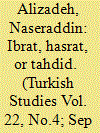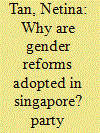| Srl | Item |
| 1 |
ID:
180533


|
|
|
|
|
| Summary/Abstract |
This study examines the ways in which various aspects of Turkish modernity, including gender reforms and nation-building, were reconstructed by the Berlin Circle, whose members were the ideologues of nationalist authoritarian modernization in Iran. To this end, I analyzed texts published between 1923 and 25 in Iranshahr and Nameye Farangestan, two important periodicals of the Berlin Circle. The results of this study show that while gender reforms were welcomed, longingly desired [hasrat], and upheld as a lesson [ibrat], Turkish nationalism was mostly perceived as a threat [tahdid]. This decentralized and horizontal view towards Turkish modernity suggests that its reconstructed image served to transfer and propagate different messages that implied the possibility of modernization reforms in an Islamic country like Iran and induced anxieties to push Iranian society to an imagined ideal future.
|
|
|
|
|
|
|
|
|
|
|
|
|
|
|
|
| 2 |
ID:
145756


|
|
|
|
|
| Summary/Abstract |
In Singapore, the percentage of elected female politicians rose from 3.8 percent in 1984 to 22.5 percent after the 2015 general election. After years of exclusion, why were gender reforms adopted and how did they lead to more women in political office? Unlike South Korea and Taiwan, this paper shows that in Singapore party pragmatism rather than international diffusion of gender equality norms, feminist lobbying, or rival party pressures drove gender reforms. It is argued that the ruling People’s Action Party’s (PAP) strategic and electoral calculations to maintain hegemonic rule drove its policy u-turn to nominate an average of about 17.6 percent female candidates in the last three elections. Similar to the PAP’s bid to capture women voters in the 1959 elections, it had to alter its patriarchal, conservative image to appeal to the younger, progressive electorate in the 2000s. Additionally, Singapore’s electoral system that includes multi-member constituencies based on plurality party bloc vote rule also makes it easier to include women and diversify the party slate. But despite the strategic and electoral incentives, a gender gap remains. Drawing from a range of public opinion data, this paper explains why traditional gender stereotypes, biased social norms, and unequal family responsibilities may hold women back from full political participation.
|
|
|
|
|
|
|
|
|
|
|
|
|
|
|
|